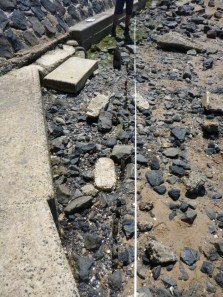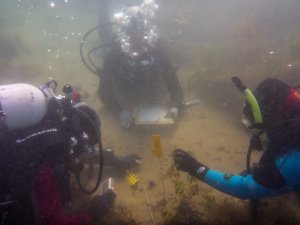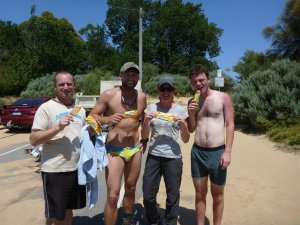By Peta Straiton, Mark White, Richard Pauley and Jonathan Bauer
After the long 868 kilometre trip from Adelaide to Phillip Island, Victoria, all field participants were keen to get straight into work [after a good night’s sleep of course]. Participants were divided into colour coordinated groups. We, the “Blue Team” consist of Mark White, Jonathan Bauer, Peta Straiton and Richard Pauley, and is supervised by the wonderful Jane Mitchell, and the beautiful Julie Mushynsky.
Unfortunately, the Blue Team’s plans for day one were thwarted by bad weather which made for unsafe diving conditions. To combat their dismay the Blue Team (along with all the other teams) worked in their groups to refresh their skills in conducting baseline-offset surveys, trilateration, and photography.
With more promising weather on the second morning all divers headed out to the beach to ensure that everyone’s skills were up to scratch. Luckily everyone passed. Despite a slight breeze, the search for the underwater site began. The Blue Team was scheduled to be the second group in the water, however, the weather once again turned sour. Strong surges and limited visibility rendered the site unsafe. Fortunately for the Blue Team we were still able to catch some sun on the beach and even under take some foot surveys do a little bit of work.
Wednesday proved to be a far more successful day for the Blue Team. We travelled to Rhyll Beach where a cool breeze and hot sun could not stop us from undertaking magnetometer surveys, conducting metal detector sweeps, gathering GPS points and performing baseline-offset surveys.
The team, in conjunction with John Jansson (a local historian and shipwreck enthusiast) were trying to locate an old wreck that was originally named the Oscar but was later called the Ventnor. Mr Jansson provided us with valuable information about the history of this vessel.
Built in 1874 as a 29-ton, 73-foot scow hull at Footscray (Melbourne) for the Carlton and United Breweries, the vessel regularly transported beer to Williamstown (J. Jansson pers. comm. 5/2/14). However, in January 1923, the vessel was purchased by the Phillip Island and Western Port Steam Shipping Company to act as a ferry after they added a wheel house. The vessel was to be captained by Jack Johanaugust Jansson, Mr Jansson’s grandfather (J.Jansson pers. comm. 5/2/14). In 1925 the vessel was laid up and its superstructure dismantled. The remains of the hull were later beached and dismantled. John Jansson (pers. comm. 5/2/14) confirmed that this timber-built ship contained metal fastenings for the team to discover.
To assist with the growing population of the island and Rhyll Beach’s popularity a seawall was constructed to provide a stable area near the beach where families could sit and relax. The seawall currently rests directly on top of the vessel’s remains. While the data from the magnetometer is still being processed and analysed, the metal detector did manage to locate several features and may possibly be the fastenings of the ship’s hull.
By using the baseline-offset survey technique, we recorded the remains of the old retaining wall for the original slipway (Figure 1). Located on the eastern side of the current slipway and surrounded by basalt rock, these remains help to define the extremities of this original access point.

Figure 1: Remains of the timber slipway retaining wall, facing northwest.
Photo taken by Peta Straiton.
Thursday proved to be a day full of learning, excitement and challenges that the Blue Team were ready to face head on. By 8:00 AM, we were on the road to the boat ramp to finally dive the site; the site we had all come to see. After a small hiccup (of misplaced diving equipment), we entered the water for our first dive, and what an amazing dive it was. Flat calm seas, good visibility, and hardly a breath of wind. The team did not waste any time, going full force into their assigned tasks. Laying a baseline for surveys, photographing features and creating site plans. All was going well until we got out of the water only to discover we had lost the entire site plan and photo log.
After changing our tanks, eating lunch and quickly discussing what we did well and what needed improvement, we were back in the water with stronger plans, stronger minds and more determination than ever. Continuing with the tasks we did not finish (or re-doing what was lost), the team were all smiles and laughs as they hauled themselves into the boat to return to camp, happy with a job well done (Figure 2).

Figure 2: Peta Straiton, photography, Richard Pauley recording with Julie Mushynsky.
Photo taken by Jonathan Benjamin.
Friday morning was similar to Thursday, with the team packing to be ready to leave at 8:00 AM. Continuing with baseline-offset measurements and scale drawings, the first dive went smoothly. Returning to shore with a sense of accomplishment the team changed tanks, ate, and once again returned to the site. While the second dive proved to be more complex than the last, with strong surges and visibility down to one metre, the team proved that we have what it takes to get the job done.
With the first week at an end and the second just about to begin, all team members are enjoying the complexities that the field school presents mentally, emotionally and physically. We have all enjoyed the camaraderie that has developed, and we have already created memories never to be forgotten. All we can say is that, so far, we have had a positively Gaytime (Figure 3).

Figure 3: Richard, Mark, Jane, and Jon, enjoying an Aussie Golden Gaytime.
Photo taken by Peta Straiton.

